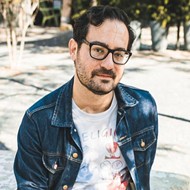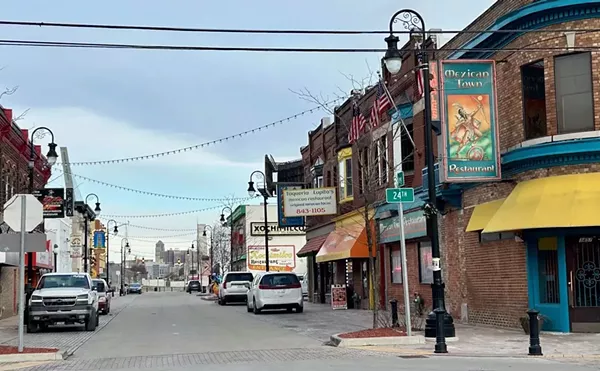A few years ago, Andy Didorosi was running a liquidation company that helped clients sell assets online. When he found some buses for sale from Ferndale Public Schools, he got the idea to put them to use transporting the bar-going crowd from the suburbs to downtown Detroit. A tinkerer since he was an adolescent, Didorosi threw himself into the enterprise entirely, launching the Detroit Bus Company, where he has refurbished and even drives a fleet of brightly painted buses that's known for offering a variety of fun, historical tours of the city.
Now, the Detroit Bus Company is prepping for a new project, the Youth Transit Alliance, which will help ferry kids in Southwest Detroit to after-school programs. With the new school year approaching, we stopped by the Detroit Bus Company's headquarters in Hamtramck to learn about the new program.
Andy Didorosi: This is the first year that we're actually integrated with Detroit Public Schools. We're part of their official framework, rather than offering a service that just benefited their students. Now there's fliers in the registration packets, and the school is telling parents that we're available. The community coordinators that work at each school are aware of what we do.
MT: What services will the Youth Transit Alliance provide?
Didorosi: We're acting as both a ride home and a new opportunity for kids to get to these after-school programs and then get home safely. Before, you basically had to choose between your after-school program or your ride home. They wouldn't have buses run at the end of these programs, because you're talking around twice the amount of busing.
MT: Where is your funding come from?
Didorosi: The Skillman Foundation approached us summer of 2013 to solve this transportation issue they were having. They have all these after-school programs, and they want to get kids to them, but then they wanted a big grant to do transportation and it really just didn't make any sense. Sometimes the transportation grant would be as much as the funding for the program or more.
It will have a number of different sources of revenue. The programs will contribute a small amount, somewhere like 2 to 4 percent of the total operating budget. The programs will subsidize it a very small amount for their enrollment in it. We're launching a crowdfunding component at Youthtransit.org. We're looking for people to back students' transportation. By then we'll figure out what that number is to back it for a month. The people who are putting up Detroit and saying this is the future city, this is for them to put their money where their mouth is. If we're going to want more social enterprise solutions to problems like this, there's got to be a funding model.
We came to the funding that made sense. (Skillman) funded the first year outright: 100 percent support. The second semester grew in size a bit. For this year, they really wanted us to differentiate our funding streams. So while Skillman Foundation is supporting it, they're not covering 100 percent of the tab. One of those reasons is because the tab got four times bigger. The program budget was around $183,000. This year we're looking at about $580,000 for those four buses.
MT: Why did the budget grow?
Didorosi: We're getting more efficient, but because the customer service is there — we've got a conductor on the buses, the buses are GPS-tracked, there's a huge community leadership component. It's a far more costly service to run because it's not being run like garbage pickup. There's a reason why there's Whole Foods when there's Wal-Mart. We've got to have this be a holistic system that really takes the needs of these kids into consideration, and that can't be done the way this is typically done.
MT: So if you're going to do this, you're going to do this right.
Didorosi: Usually when kids come home, they're coming home at 3:30 in the afternoon, it's light out, they get dropped on a corner and they walk three or four blocks home. With this, we're dropping kids right off at their door. Elementary school kids get a walk hand-in-hand up to their door, because they're getting home in the winter time at 6:30 at night and it's dark out.
And they shouldn't walk those four blocks. The public system is done en masse, which is more feasible. This is door-to-door, which is much slower, and a lot more costly — but it's the only thing that's possible. You can't drop a kid off in Delray and then say, "Good luck, walk past that steel mill that's not operating anymore."
MT: So is the YTA your main project now? Are you doing less of the bar tours?
Didorosi: The goal since Day One has been to fill transit gaps in the city of Detroit. The tours that we do are supplemental income to keep our mission going. There's no reason to have the buses sit in the parking lot over the weekend. There couldn't be the YTA without the charters and tours.
We really wanted to make the YTA our sole charge. Unfortunately, the bar-going crowd lost a really kick-ass service. But I believe that they would agree with us that getting kids to after school programs is a noble good. Motherfuckers got Uber now, anyway. — mt







